The Goonhammer Open UK 2023 was held on the weekend of the 3rd of September 2023 and alongside the Warhammer 40,000 tournament we ran a Horus Heresy Narrative event. This years 28 fearless warlords took part in the clash over the city of Marinus, while two Supreme Commanders oversaw their forces. In this article Lupe takes a look at what happened, relays the narrative and the events of the games, and shows off the lovely armies and tables. In the next article he’ll dive a little deeper, looking at the campaign system and how it worked as well as how it didn’t. Finally in part three he’ll take a look at what changes we’ll think about for next time, and have some reflections on the pressures of running narrative events.
On the world of Arvox IV a battle rages. Through the streets, docks, industrial works and parks of Marinus terrible fighting consumes the very fabric of this place. Marinus, a gleaming city that was once prosperous and bustling, fuelled by wonders from the dark age of technology, is a prize worth spilling endless blood for. It has little strategic value, and contains no caches of terrible weaponry (alright, maybe one or two). But the entire city is powered by forces unknown, and there is technology here that none have ever seen before, even the Emperor Himself. The opportunity to rip it to shreds and discover its secrets is one that cannot be passed up.
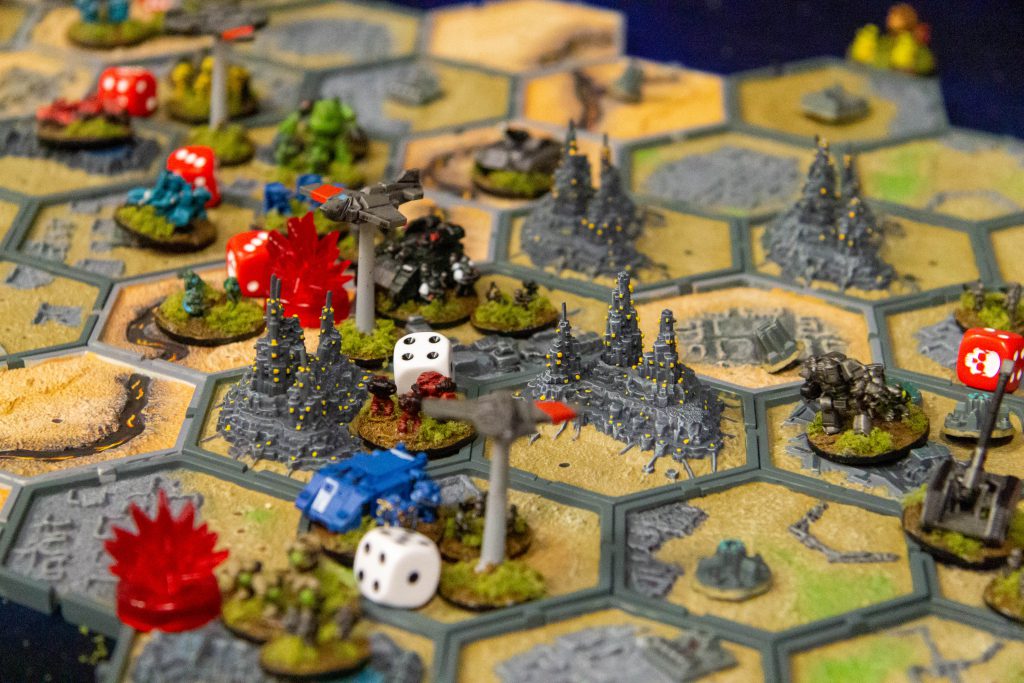
Marinus of Arvox IV
Marinus is (was, now) a city that was brought to Imperial Compliance in the early years of the Great Crusade. It’s a relatively familiar kind of place of the era – the seat of the planetary governor who rules in the Emperor’s name, a bustling mega city complex that sprawls across the landscape and which is home to a number of small hives, as well as dozens of more traditional settlements and districts. It’s divided in two, cut in half by the Conduit, a molten river of metal that springs up from the depths on the east of the city and disappears underground again in the west, though from where and to where is a mystery. This river is the source of the city’s power, with substations built to capture the energy it generates arrayed around it, and then “tributaries” of this molten river being diverted to further flung areas to bring power there.
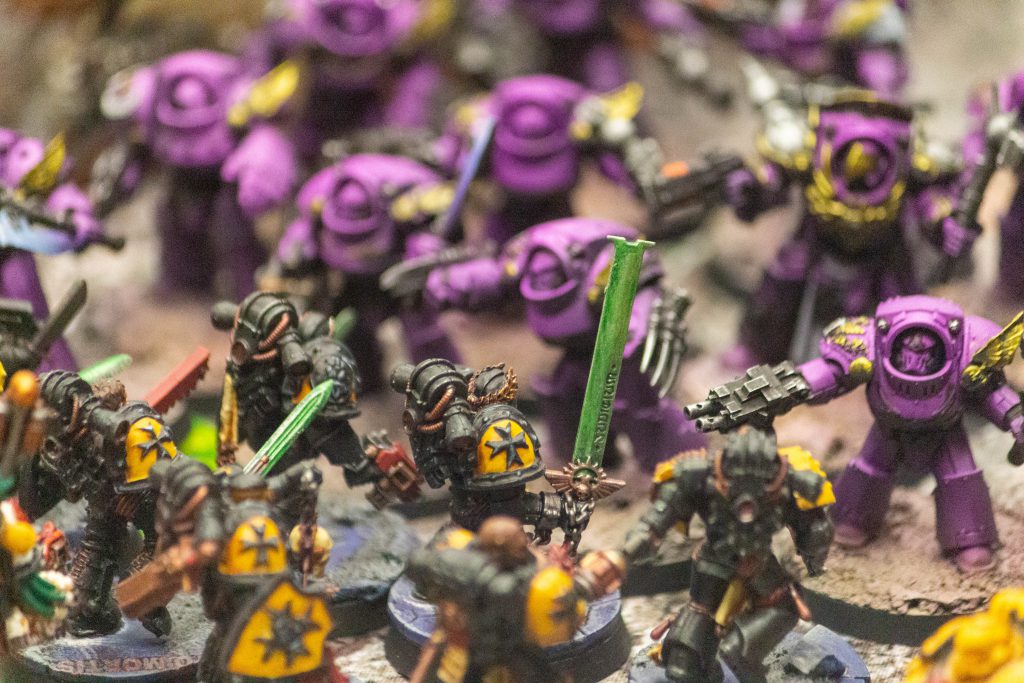
Credit – @__aodhan__ and @le_swordfish
The Conduit bisects the city into the northern half, the Alorn Heights, which is home to the majority of the population and the four small hives that dominate its skyline, and the southern half, the Parallel, which is home to the vast industrial capacity of the city and its many manufactories. To the south of the Parallel, beyond the city limits, is the Dustbowl, an arid and desolate land which was once home to many essential mineral resources but which has been long since stripped and left to the handful of nomadic peoples who scratch out a living. To the north of the city, past the Alorn Heights, is the Polinisium, a tropical jungle and agricultural hub that feeds the city and is the dominion of the genescientists and the Water Guild who keep the population fed with their experiments. Further north and south of these are wide stretches of mountainous terrain, making the city itself a natural chokepoint east to west. Finally, below the surface lurks a secret darker world, the Necropolis, the vast tunnels and caverns of steel that house much of the city’s infrastructure, and in which the Guilds rule supreme.
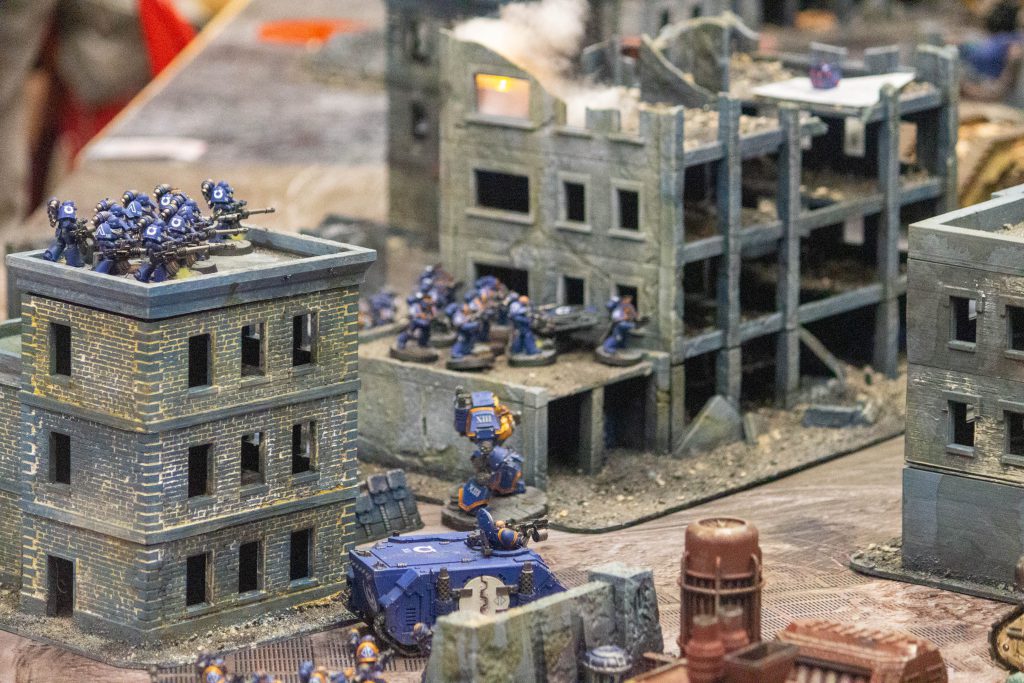
It is in this city that the Battle of Marinus will take place, spread throughout the Alorn Heights, Parallel, the Polinisium, the Dustbowl and the Necropolis – the fronts in this battle between those loyal to the Emperor, and those who have thrown in with the Warmaster.
Leading the Imperial forces was Rogal Dorn (portrayed this weekend just gone by Liam) while the Traitors were initially led by Mortarion, before the Primarch of the Death Guard was called away on urgent business, leaving Conrad Kurze in charge (portrayed this weekend by Toby). These two Supreme Commanders oversaw a vast army made up of several grand and minor companies of troops drawn from the various legions and also their Mechanicum and Auxilia allies. Supporting them were the local Militia Regiments, who took a less active role in the fighting, but provided essential support.
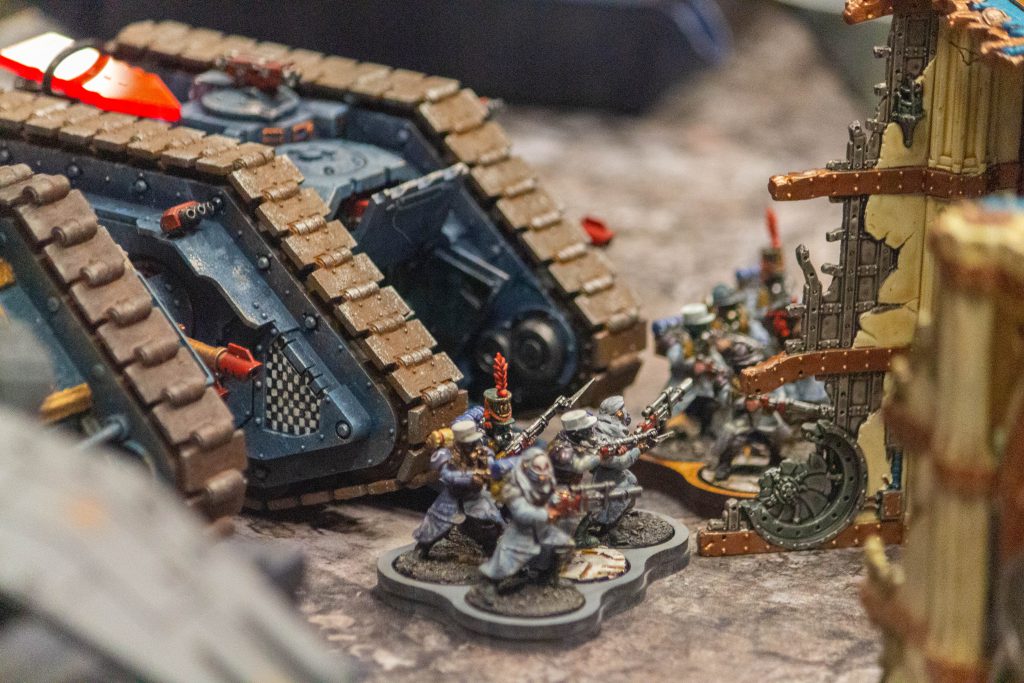
The Eve of Battle
The Loyalists made planetfall at the western edge of the city, and linked up with those militia still loyal to the Emperor. The majority of the militia forces, as well as the planetary governor, have fell in line with Lord Dorn and a powerful base of operations was established for their campaign. Dorn began to rally local forces to their banners, including representatives of the Water Guilds, which would prove helpful in the coming days.
The Traitor forces meanwhile linked up with the Mechanicum presence in the city including the Archmagos. These forces established landing sites in the city and after a short bombing campaign the traitors landed and built their encampment in the heart of the city. Rumours raged that they immediately recruited local cults, formerly suppressed according to the imperial truth, to their cause, and whispers of strange occurrences began to spread.
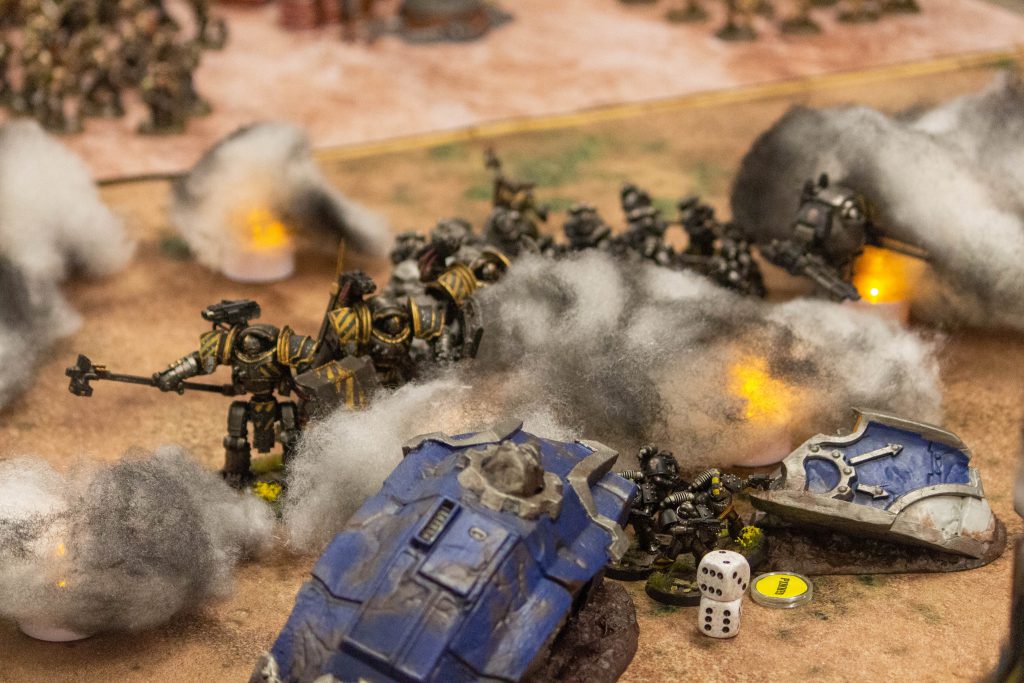
Soon the forces were establishing their command bastions – the Loyalists in the west, and the Traitors in the east. Dorn chose the Alorn Heights for the site of his bastion, to give him access to the hives, while the Parallel was deemed most important by the traitors. It was around this time that Mortarion was called away and Curze took over command, and he immediately sent detachments of scouts into the city to evaluate the situation and start making bloody examples of local populations that didn’t fall in line. Dorn also dispatched reconnaissance units, but their first priority was to safeguard the populations and try and identify the specific locations of enemy units.
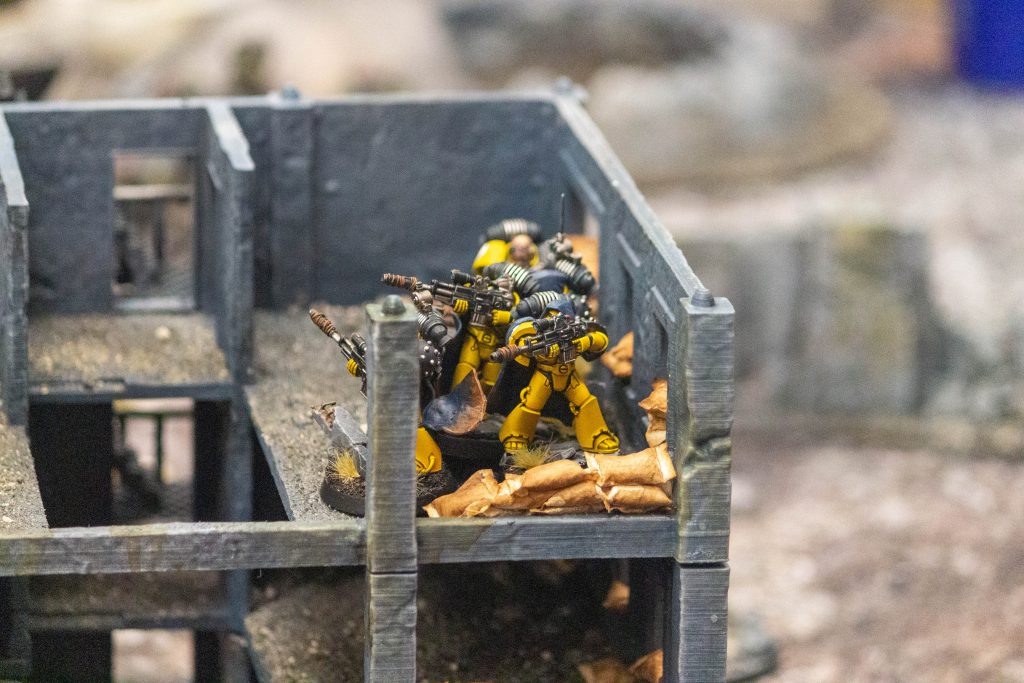
As troops began to arrive from orbit the Supreme Commanders had to decide how to instruct their scouts in position. How should they prepare for larger troop formations to arrive? Dorn was cautious, using a mixture of delaying and sabotage tactics alongside more traditional scouting and surveying. This led to the loyalists identifying key resources within their territory early on, an advantage that would remain through the campaign and would eventually contribute to their victory. Curze meanwhile abandoned any scouting or surveying and immediately sent the scouts out into the city engage in ambushes, delaying manoeuvres, sabotage runs and terror tactics.
As the frontline forces were arrayed the Supreme Commanders next had to decide where to deploy them. In the end the loyalists sent their strongest contingents to the Alorn Heights, the Polinisium and the Necropolis, with only light resistance being offered in the Parallel and Dustbowl. The Traitors spread their forces more evenly, though they also went relatively hard into the Alorn Heights and Necropolis. When the first clashes had ended and the battlelines were drawn the Traitor advance in the Parallel was extensive, a spearhead almost reaching the very edge of the city, while their position in the more northern fronts was a lot more uncertain. Vicious fighting with superheavy armaments in the Necropolis also lead to tunnel collapses, leaving one area of the city collapsed and dangerous, which would cause issues later for some of the warlords fighting in it.
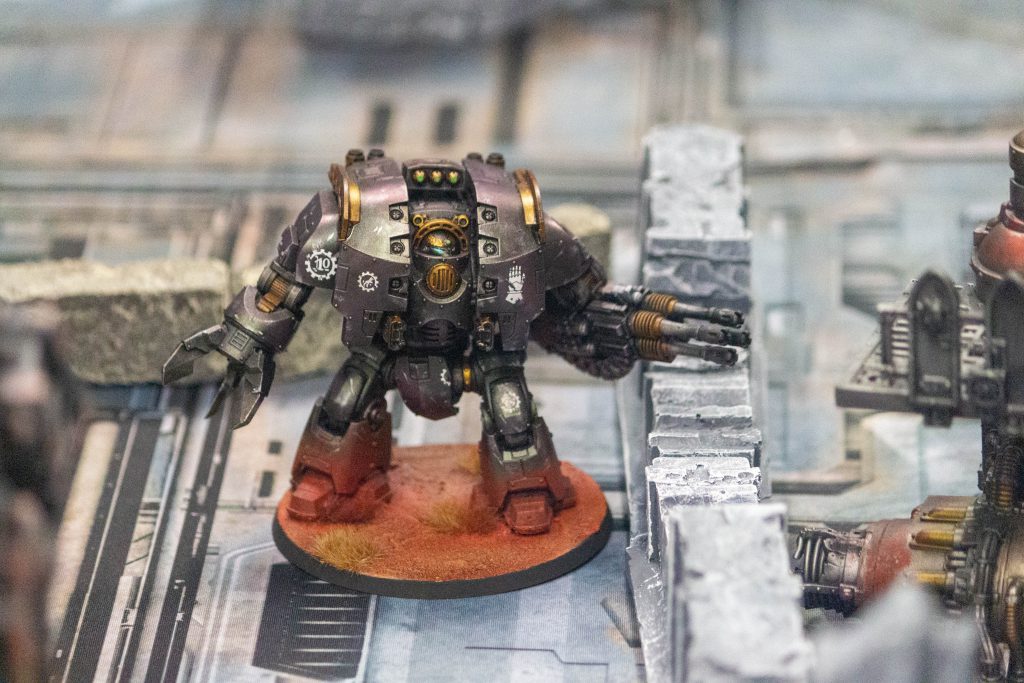
With artillery moved into position, militia regiments formed up and digging entrenchments, and armies deployed to the battlelines, the battle of Marinus was ready to begin.
The First Day
The early clashes in the morning set the tone for what would follow across the weekend. In the first game Curze instructed every single battleline force to push the line as hard as possible, and gave every single commander additional missions to accomplish. His intention was to move the battleline as far as possible and perhaps encircle the enemy with their spearhead, and also to judge the performance of his underlings by how well they accomplished their secondary objectives. This meant that in fronts where traitors had the advantage territory would be won or lost quickly and the outcomes of battles would be fierce.

In the loyalist held territories however, things were different. Though Dorn ordered some advances, he was more cautious, instructing many of his forces to secure the territories they already held, hoping to build up a resource advantage that would help overcome the traitors the next day.
The loyalists took strong wins in the first round, with eight of thirteen battlefields giving them victory, but strong traitor victories particularly from the Emperor’s Children and Word Bearers (well done Matt and Marcus) kept the Victory Points pretty level going into the second battle of the day.
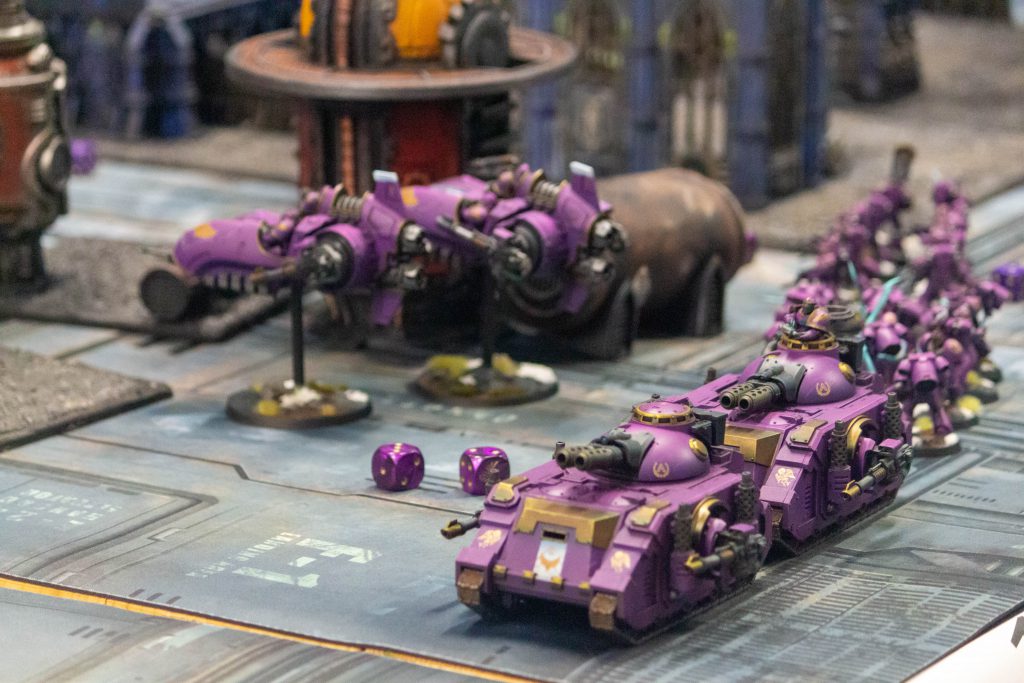
In the afternoon Dorn once more exerted some caution, instructing all commanders in the Parallel to secure their existing territory, rather than risk losing any ground to the traitors that might lead other forces encircled. This paid dividends and it was really in this fight that the weekend was won for the Loyalists. Quick work from a number of loyalist warlords caused the regulators that control the flow of the Conduit to be destroyed, and the resultant energy spike caused the great molten river to overflow its banks and flood surrounding areas with radiation. The loyalist commanders in the Parallel were quick to turn this to their advantage and they almost all won their games very convincingly with the only loss being by a single point, with a score of 82 to 26 VP across the four tables. This huge lead in this one front constituted a big part of the final outcome of the campaign, and so Mark, Oliver, Aaron and Howie should all be very pleased with their contributions. Things were more mixed everywhere, with a weather control station being offline causing catastrophic storms in the Dustbowl and cutting short both games there as weapon ranges halved.
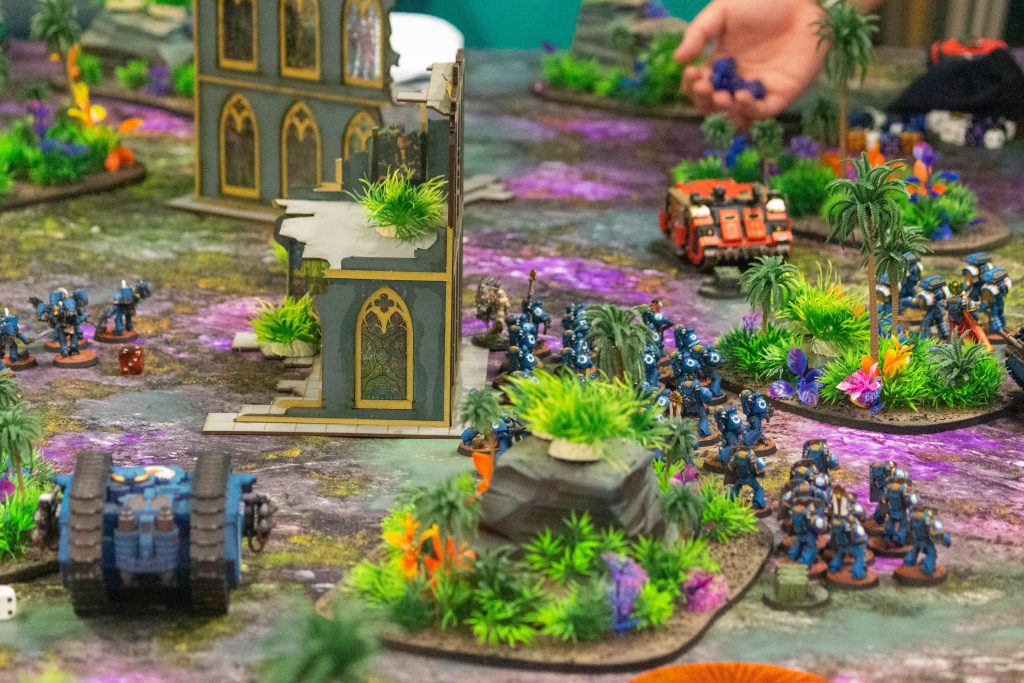
However this explosion of the Conduit caused the virus cache that was being recovered in the area to detonate, which would cause considerable issues for everyone in the morning.
The day done, the crew went and ate vast quantities of Indian food, which I’m sure is how all generals celebrate a hard day’s war in the 31st millennium.
The Second Day
The morning of the second day showed a grim portrait of the city: one of the four hives had been consumed by the gas released by the virus bomb and millions were dead. Whole regiments of militia had been wiped out by the spread. The Legions Astartes fared better, given their sealed power armour, and could still take to the field but it was a rough time. Three tables found themselves treating the entire field as dangerous terrain other than for their vehicles, and losses on these tables were brutally high. Worse, across the fighting a number of warp instabilities had been opened up, aided by the cultists that Curze had stirred up in the city, and now these started reverberating with the psychic powers used leading to vast reality cascades – warp ruptures that enveloped entire fronts. The Polinisium was hit first, and then the Alorn Heights, plunging the most populated area of the city into nightmare and horror.
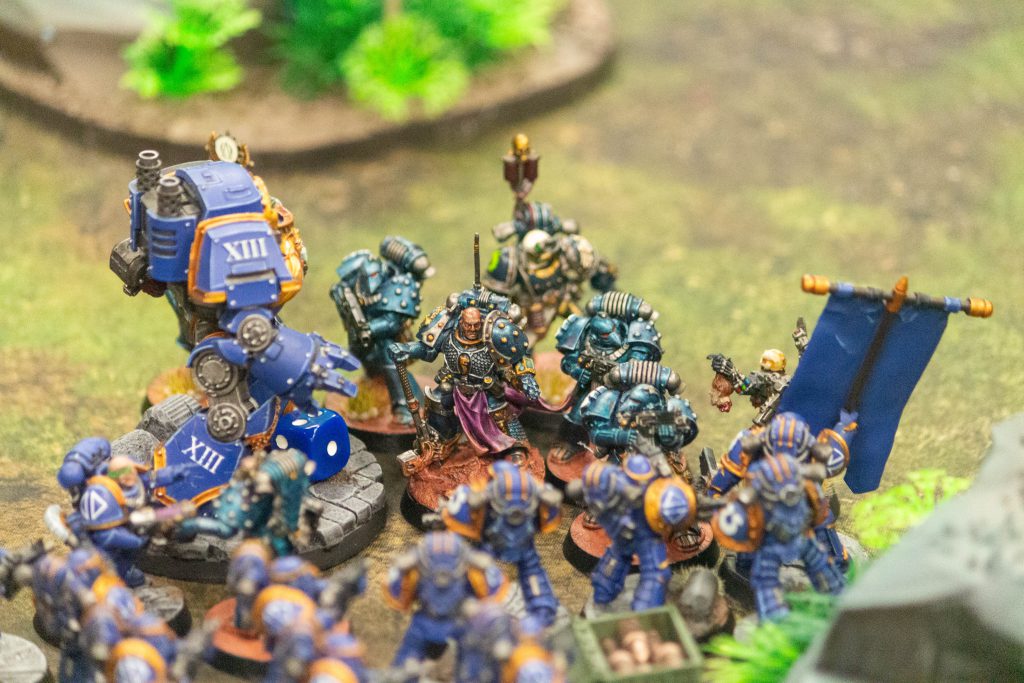
Through this though, the forces took to the field. In the first game of the day there were notable battles on both sides. In particular Ben (who would go on to win best loyalist) and his Ultramarines handily defeated the Word Bearers, making best use of the virus drift and crushing his foe. On the other side a notable victory went to Connor who commanded a large Mechanicum detachment, which crushed his Ultramarine foe with logic and precision. In this round it looked a lot like the traitor would claw back the advantage, and they closed the gap sharply, drawing very close to level. The last round would be the decider.
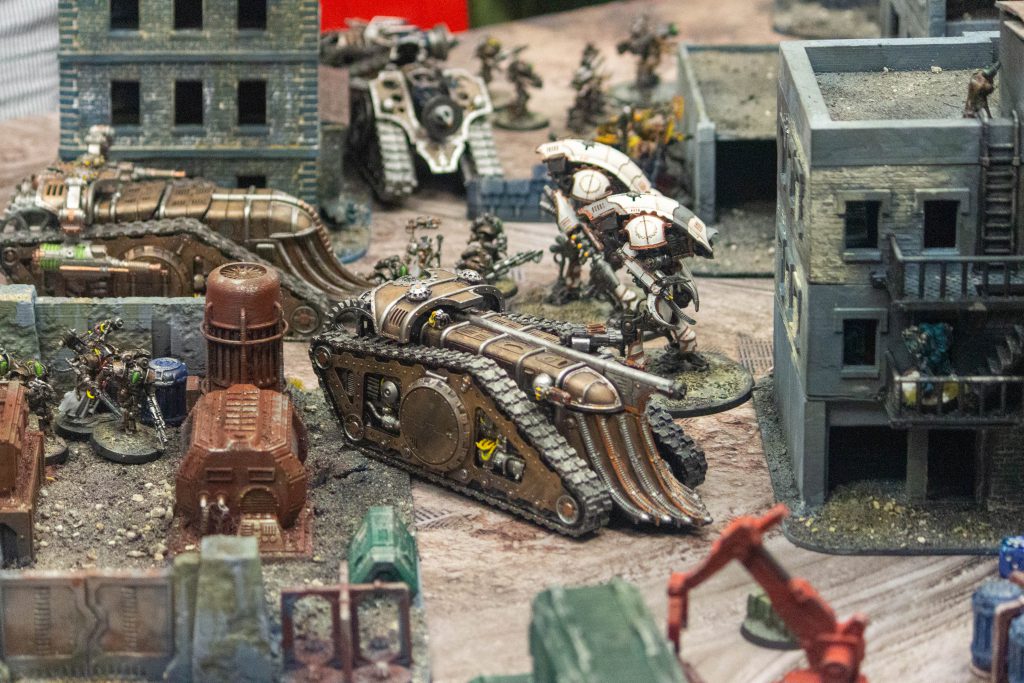
Thus our weary warlords fought on into the afternoon. However, the warp incursions and reality cascades had taken their toll and, driven by Kurze’s habit of leaping through these reality bubbles to ambush his foes, the city tore itself apart into warp madness. Reality bled away, space and time melting and bending, and the souls of the departed leaving fiery trails though the material world as much as the warp. In this last game a special rule hit every single table – when the last model of a unit was removed from play, all units within 12″ of that model suffered perils of the warp. It was bloody to say the least, and soon the fighting on the surface was either closing in to close bloody brawls, or the dust was already settling. But things were not yet decided, because into the depth beneath the city the Primarch Rogal Dorn rode with his retinue to lend aid to his trusted first Captain Sigismund. Seeing this opportunity, Kurze dispatched several forces to draw out Dorn, and weaken him, and when the mighty warrior was wounded Conrad Kurze teleported into the Necropolis with his retinue of terminators, and engaged his brother in single combat, slaying him brutally. A chant of DEATH TO THE FALSE EMPEROR went up from the traitors and echoed around the hall.
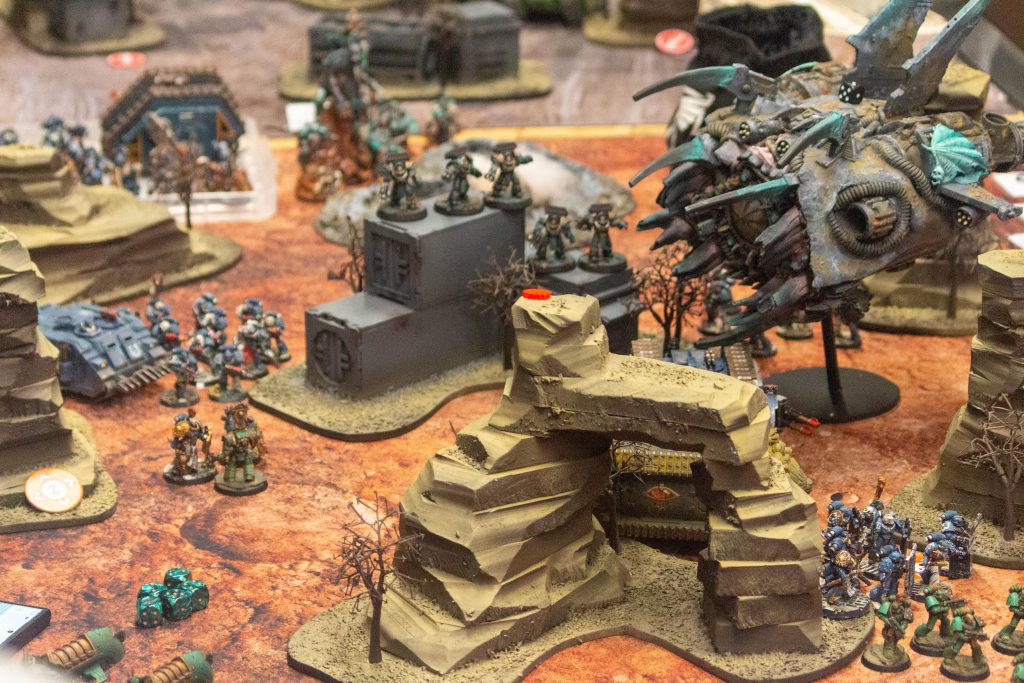
Aftermath
But as the dust settled, and the blood spilt was counted, as the territory was ceded or held by desperate lines of militia, it became clear that it had not been enough. Though Dorn was dead, slain by Curze and his body defiled, the Imperial lines did not bow, and they did not break. Slowly, methodically, they advanced, using all the resources Dorn had carefully captured as best they could, and the traitors could no longer hold on. Kurze and the forces of the Warmaster fled the city at the last, as loyalist legionaries and titans walked the blasted landscape of the once great city, free to seize their prize.

The final results for the fronts across all games were Loyalist wins in every single one. The final results were:
- Dustbowl: 65VP to 50VP
- Parallel: 170VP to 130VP
- Alorn Heights: 158VP to 148VP
- Polinisium: 61VP to 52VP
- Necropolis: 54VP to 29VP
They also held more districts of the city by the end of the weekend – 40 to the the traitor’s 32. They ended the campaign with more supplies and better logistics behind them, and they had control of the Conduit itself. However the traitors had managed to capture (and destroy) the weather control stations, and the damage from the warp and the death of Rogal Dorn gave them some advantage. Taking into account all factors and awards the final campaign score was a victory to the Loyalists:
- Loyalists: 988 Campaign Points
- Traitors: 829 Campaign Points
And with that, we’re done for today. Next time I’ll really dive into the guts of the campaign, how it works, where those campaign points came from, how the games were organised and lots of other details.


